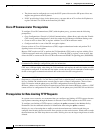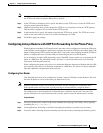
17-18
Cisco ASA Series Firewall ASDM Configuration Guide
Chapter 17 Configuring the Cisco Phone Proxy
Configuring the Phone Proxy
Step 4 Specify the minimum and maximum values for the RTP port range for the media termination instance.
The minimum port and the maximum port can be a value from 1024 to 65535.
Step 5 Click Apply to save the media termination address configuration settings.
Creating the Phone Proxy Instance
Create the phone proxy instance. To have a fully functional phone proxy, you must also complete
additional tasks, such as creating the MTA and enabling SIP and SCCP (Skinny) inspection. See Task
Flow for Configuring the Phone Proxy, page 17-14 for the complete list of tasks.
Prerequisites
You must have already created the CTL file and TLS proxy instance for the phone proxy.
See Creating the CTL File, page 17-15 and Adding a TLS Proxy Instance, page 18-9.
Note This feature is not supported for the Adaptive Security Appliance version 8.1.2.
Use the Configure Phone Proxy pane to add a Phone Proxy.
This pane is available from the Configuration > Firewall > Unified Communications > Phone Proxy
pane.
Step 1 Open the Configuration > Firewall > Unified Communications > Phone Proxy pane.
Step 2 Check the Enable Phone Proxy check box to enable the feature.
Step 3 Check the Apply MTA instance to Phone Proxy check box to add the media termination address to the
Phone Proxy instance. You must have a media termination address instance configured. The configured
address is added to the Phone Proxy instance.
Note To configure the media termination address, click the Configure MTA button. The Media
Termination Address dialog box appears. Once you click the Add MTA instance to Phone Proxy
check box, the media termination address instance cannot be modified and the button changes to
View MTA Configuration. To change the media termination address, uncheck the Add MTA
instance to Phone Proxy check box.
Step 4 If necessary, add a TFTP server for the Phone Proxy. To add a new TFTP server for the Phone Proxy,
click Add. The Add TFTP Server dialog box opens. See Adding or Editing the TFTP Server for a Phone
Proxy, page 17-20.
Note The TFTP server must reside on the same interface as the Cisco Unified Call Manager. Additionally, If
NAT is configured for the TFTP server, the NAT configuration must be configured prior to configuring
the specifying the TFTP server while creating the Phone Proxy instance.
Step 5 Specify the CTL File to use for the Phone Proxy by doing one of the following:
• To use an existing CTL File, check the Use the Certificate Trust List File generated by the CTL
instance check box.


















